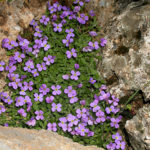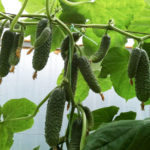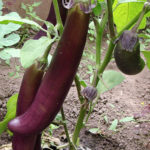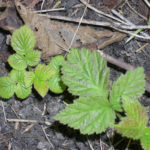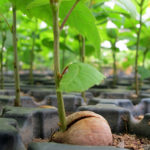Why does the apple tree shed fruit?
Many novice gardeners are seriously worried when they find fallen fruits under the apple trees. “Why is the tree dropping apples? Should I sound the alarm? What measures need to be taken? " - these are the main questions that the amateur gardener is trying to find the answer to. Today we will try to sort out the situation together.
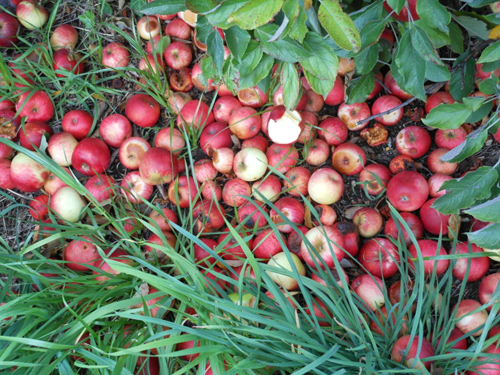
Physiological reasons
If you carefully observe the flowering process of apple trees, you will notice that the central flowers bloom first on the branches, and then the so-called reserve flowers, located in a spiral. Mature trees are capable of producing a huge number of flowers, but their ability to bear fruit is limited to 6-8 percent, so even if 5-10% of reserve flowers remain, this is considered a good indicator. Under favorable conditions, a high percentage of fertilization and ovary formation is observed. This creates a peak load, that is, the tree cannot grow that many apples. That is why it sheds part of the ovaries. Moreover, experienced gardeners use special chemicals that stimulate the dropping of a part of the ovaries.
If the tree is experiencing a shortage of nutrients or moisture, then it is possible that underdeveloped fruits fall off - this is already an alarming symptom.
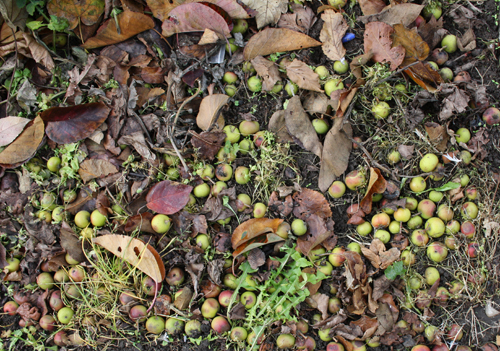
As a result of numerous experiments, a set of measures has been developed that ensures annual and abundant fruiting of apple trees:
1. application of nitrogen fertilizers at the end of the flowering phase;
2. re-feeding with nitrogen after dropping a part of the ovaries;
3. phosphorus-potassium fertilizing in the phase of decline in the work of the root system;
4. pruning after harvest;
5. application of a full range of fertilizers when preparing trees for wintering;
6. pest control, timely watering and foliar feeding during the entire growing season.
Apple moth - the reason for dropping fruits
If you cut the carrion, then you can immediately conclude why the tree drops apples. If its inside is clean, then this is due to a lack of nutrients or moisture. If the insides are wormy, this is the work of the moth.
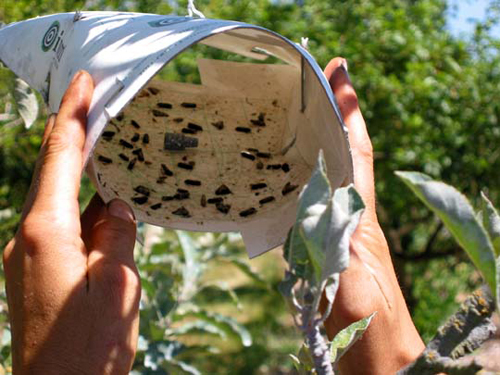
The apple moth (Cydia pomonella) is the most common garden pest. This is a small nondescript butterfly that appears 20-25 days after the winter varieties of apple trees have flowered (the beginning of flowering of white acacia) and lays eggs on the leaves or on the surface of the fruit. One female is able to lay up to 220 eggs, and if preventive measures are not taken, the number of damaged apples can reach 80-90%.
To combat the codling moth, it is necessary to carry out a set of measures.
1. Treatment of apple trees with insecticides:
- 18 days after the end of flowering winter varieties;
- 2 weeks after the first treatment;
- 12-14 days after the second spraying;
- 2 weeks after the third treatment;
- no later than 3 weeks before harvest.
The expediency of insecticide treatment is indicated by the arrival of a butterfly on pheromone or light traps.

2. Applying trapping belts to tree trunks, which are checked every week and the moth caterpillars are selected from them. After harvesting, the trapping belts are burned. This method can significantly reduce the harm caused by the pest. In old gardens, the number of caterpillars under the trapping belt often reaches 500 or more specimens.
3. Timely collection of volunteers and their disposal.
4. Catching butterflies using light and pheromone traps, as well as traps with odorous baits (molasses, kvass, compote).
5. Autumn cleaning of the bark from the upper layer, under which the caterpillars hibernate.
6. Fumigation of burning sulfur of fruit storages, containers.
Recently, many gardeners have abandoned the use of insecticides, preferring to carry out the treatment using bacterial preparations, for example, lepidocid, dipel or bitoxibacillin. Bacterial preparations have the advantage that their use does not harm the entomophages of the codling moth - its natural enemies, of which, for example, there are 26 species on the territory of Ukraine, and more than 120 in the world.
References:
- "Atlas of pests of fruit and berry crops", P. P. Savkovsky;
- "Life of a Garden", V. G. Shaikin;
- "Biological protection of the garden", V. M. Tkachev.
